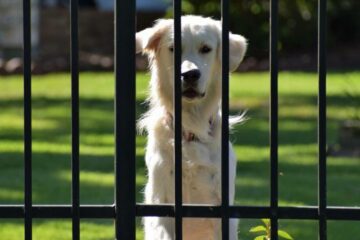Are Ladybugs Poisonous to Dogs? Can Dogs Eat Ladybugs?
Are ladybugs poisonous to dogs? Can dogs eat ladybugs? In this article, we’ll answer everything you need to know including teaching you the simple commands that will stop your dog eating ladybugs (or any other insects) once and for all. And if your dog ate a ladybug already, we’ll tell you what to do next.
We’re then going to move on and teach you how to get rid of ladybugs from your home in a way that’s humane and also safe for your dog. We’ll finish by covering a few more important things you should know, such as do ladybugs bite dogs, and how do you recognize the difference between Asian beetles and ladybugs? Keep reading!
Are Ladybugs Poisonous to Dogs?

Ladybugs are not poisonous to dogs and pose little to no threat. However, certain species, such as the Asian lady beetle, can cause minor digestive upset if ingested in large quantities. It’s always wise to prevent your dog from eating ladybugs as much as possible.
Are Ladybugs Toxic to Dogs?
The majority of common ladybug species pose no toxic threat to dogs. These insects’ vividly colored shells function as a natural deterrent to predators rather than a harmful agent. However, there are some exceptions.
The Asian lady beetle, for instance, can secrete a yellow fluid with an unpleasant smell when they feel threatened or are squashed. Although this fluid typically doesn’t pose a severe danger, it may cause minor irritation in a dog’s mouth or slight digestive issues if the dog ingests a significant number of these beetles.
What Month Do Ladybugs Come Out?
Ladybugs, also known as lady beetles, are warm-weather creatures, meaning they’re most active during the warmer seasons. In many regions, this equates to the late spring and summer months, typically making their appearance in April or May.
They tend to spend the colder months in a dormant state, often congregating in large groups in protected places such as inside tree trunks or under house siding. This can lead to a sudden “invasion” of ladybugs when they reemerge with the return of warm weather, causing them to be more noticeable and accessible to curious pets.
Training the ‘Leave It’ Command
Training your dog to respond to the “leave it” command can be an invaluable tool to keep them safe and prevent them from eating ladybugs or any other undesired objects. Here are the steps to do so:
- Begin by holding a treat in a closed fist.
- Present your fist to the dog and say “leave it.”
- Wait until your dog stops trying to get the treat and pulls away.
- Once your dog pulls away, give them a different treat from your other hand and say “good.”
- Repeat this process, gradually increasing the challenge, such as placing the treat on the floor but covering it with your hand.
- Once your dog masters the command in a controlled environment, you can practice in more realistic scenarios involving ladybugs or other distractions.
These steps will get your dog to stop eating ladybugs, but it’s important to remember that the underlying behavioral issues (prey drive, curiosity, overexcitement, etc.) that were causing all of this to begin with will still be present. And until you address those, any positive changes you see are only going to be temporary.
“Well, how do I make these changes last?”
By getting your dog to truly choose to follow your direction, that’s how. I tried many times to write out how you can do that before deciding it made more sense to just link you to the free video series that explains it better than I’d ever be able to.
The series is by a man named Dan who is one of the world’s leading dog obedience trainers. In it, he teaches you how to put an end to things like when your dog eats ladybugs and all other misbehavior using his fast and easy-to-follow methods.
In the first video, Dan will reveal to you why the two most common methods of dog training only doom you to failure. You can watch the video now by clicking here. Follow the proven system he’ll show you in his series and you’ll never have to spend another second worrying about your dog eating ladybugs ever again!
Can Dogs Eat Ladybugs?

Dogs should not eat ladybugs, despite the insects not being generally poisonous or toxic. Certain species, like the Asian lady beetle, may cause minor irritation or digestive upset if ingested in large numbers. It is always advisable to prevent your dog from eating any insects.
My Dog Ate a Ladybug
If your dog ate a ladybug, there is typically no immediate cause for concern. Most common species of ladybugs are not harmful to dogs. However, certain types of ladybugs, such as the Asian lady beetle, can secrete a foul-tasting yellow fluid which might cause minor oral irritation or gastrointestinal upset if eaten. It’s also possible that your dog may have a unique allergic reaction, although this is rare.
In most cases, if your dog has eaten a ladybug, monitor them for signs of distress, such as excessive drooling, lack of appetite, changes in behavior, or digestive upset. If your dog shows any of these signs after ingesting a ladybug, you should contact your veterinarian right away. Learn to prevent future issues in the first section.
Dogs Eating Ladybugs
Dogs may be naturally curious and tempted to eat small moving objects like ladybugs. However, it is not a good idea to allow your dog to make a habit of this. Though ladybugs are generally not toxic, ingesting any kind of insect can potentially lead to a minor upset stomach or an unexpected allergic reaction.
Moreover, it’s important to remember that dogs may not differentiate between harmless and harmful insects. If they become accustomed to eating ladybugs, they may also eat other bugs that could be more harmful.
Training your dog with commands like “leave it” can be highly effective in preventing these types of behaviors (we explain how to do it in the first section). Consistency and reinforcement of this command can help ensure your dog’s safety when exploring outside. It’s always best to discourage your dog from eating insects whenever possible.
Taking care of this now will ensure that your dog always has safe interactions no matter what they meet outdoors or in the home. You then won’t have to worry about things like your dog eating Japanese beetles, your dog eating snails, your dog eating fireflies, your dog eating June bugs, or your dog eating flies, because you’ll know that your dog will behave correctly.
Ladybugs and Dogs: Rid Your Home Safely

Ladybugs are harmless to dogs and humans, but in large numbers, they can be a nuisance. When it comes to ridding your home of ladybugs, the key is to use methods that are safe for your dogs.
Here are some effective and pet-friendly ways to manage a ladybug infestation.
- Physical Removal: If you notice a small number of ladybugs in your home, simply catch them and release them outdoors. A soft cloth or a piece of paper can be used to gently scoop them up without causing harm.
- Use of Vacuum: For larger infestations, a vacuum cleaner can be a very effective tool. Use a vacuum with a bag to suck up the ladybugs, and then release them outdoors. Remember, ladybugs are beneficial insects that help control other pests in your garden, so if possible, try to avoid killing them.
- Seal Entry Points: Ladybugs typically enter homes through small cracks and openings. To prevent this, check your windows, doors, and walls for any gaps and seal them. Weather stripping and silicone caulk can be used for this purpose and are safe for dogs.
- Natural Repellents: Certain natural substances, like citronella and clove oil, are known to repel ladybugs and are safe for dogs. These can be used to create a homemade repellent spray. However, always ensure your dog does not ingest these substances, as they can be harmful if swallowed.
In conclusion, while ladybugs are not harmful to dogs, it’s understandable that you might want to rid your home of these insects, especially during a large infestation. Using these safe and effective strategies will help you manage ladybugs in your home without posing any risk to your dog. Learn to control your dog’s behavior in the first section.
Do Ladybugs Bite Dogs?
Ladybugs do not bite dogs typically and are generally harmless. Instances of ladybugs nipping are rare and usually not harmful. However, pet owners should be aware of specific issues that may arise from a dog’s interaction with ladybugs.
- Nature of Ladybugs: Ladybugs are usually docile creatures that pose minimal threat to dogs. Their diet primarily consists of plant-based foods and small insects, and they rarely interact with larger animals like dogs. They do not possess strong jaws or stingers, which further reduces the chance of a painful bite.
- Potential for Bites: Although ladybugs don’t typically bite, in rare cases when they feel threatened, they may nip. These nips don’t usually break the skin or cause substantial discomfort, but they might startle your pet. Still, it’s important to note that this is not a common behavior among ladybugs.
- Ingestion Risks: The more significant issue arises when a dog ingests a ladybug. Certain species, such as the Asian lady beetle, secrete a foul-tasting substance that can irritate a dog’s mouth and digestive system. Therefore, it’s best to discourage your pet from eating ladybugs or any insects.
- Preventive Measures: If ladybugs are abundant in your home or yard, you might want to consider eco-friendly pest control measures. Moreover, training your dog not to eat bugs can prevent potential ingestion issues (we explain how to do this in the first section). Always supervise your pet during outdoor activities to minimize their contact with insects.
While the possibility of ladybugs biting dogs is minimal, the risk of ingestion poses a more significant concern. Making sure that your pet avoids consuming these insects and keeping your home free from ladybug infestation can help maintain your dog’s wellbeing.
Asian Beetles vs Ladybugs
Asian beetles and ladybugs are often mistaken for each other due to their similar appearance. However, they are distinct species with unique traits. While both are beneficial to gardens due to their propensity for consuming pests like aphids, there are key differences in their physical attributes, behavior, and interaction with humans.
Physical Differences Between Asian Beetles and Ladybugs
The most common ladybug, the Coccinellidae, and the Asian beetle, also known as the Asian lady beetle or Harmonia axyridis, have similar shapes and sizes. Both are round, small, and often colorful. However, their coloration and markings can differ.
Ladybugs are typically red or orange with black spots. Asian beetles can also be orange or red but tend to have a wider range of colors, including yellow and tan. One noticeable physical characteristic of Asian beetles is the presence of an ‘M’ or ‘W’ shaped mark on the area behind their head, which ladybugs don’t have.
Behavioral Differences Between Asian Beetles and Ladybugs
One of the significant behavioral differences between the two species is their interaction with humans and their habitats. Ladybugs are generally more outdoor creatures and do not typically infest homes. They are often welcomed by gardeners and farmers for their role in controlling pests.
On the other hand, Asian beetles are known to infest homes, particularly in the fall when they seek warm shelters to hibernate. This behavior, coupled with their tendency to release a foul-smelling yellow secretion when threatened, makes them less endearing to people.
Interaction with the Environment
Both ladybugs and Asian beetles are beneficial for pest control in gardens and farms as they consume a significant number of aphids and other plant-damaging insects. However, Asian beetles, introduced to many regions as a means of pest control, have become an invasive species in some areas, out-competing native ladybugs and other insects for food and habitat.
Understanding the differences between these two species can aid in correct identification and inform how to interact with them, particularly if you come across them in your home or garden. Learn the command that will keep your dog safe regardless of which of these insects they encounter by going back to the first section.
I’m sure you’re looking forward to putting this ladybugs and dogs issue behind you, so I’ll let you get started now. Good luck with everything, and thanks for reading our article “Are Ladybugs Poisonous to Dogs? Can Dogs Eat Ladybugs?”





